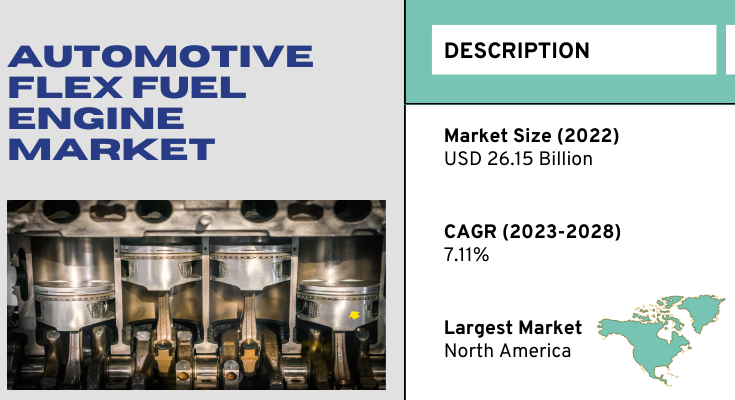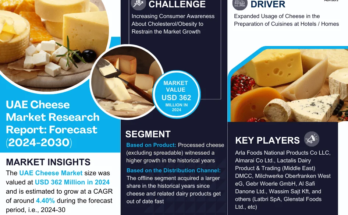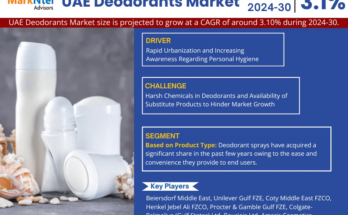According to TechSci Research report, “Automotive Flex Fuel Engine Market – Global Industry Size, Share, Trends, Competition Forecast & Opportunities, 2028”, the Global Automotive Flex Fuel Engine Market stood at USD 26.15 Billion in 2022 and is anticipated to grow with a CAGR of 7.11% in the forecast period, 2024-2028.
The global automotive flex fuel engine market is experiencing dynamic growth, shaped by a combination of environmental, economic, and technological factors. Flex fuel engines, designed to run on a blend of gasoline and ethanol, have gained prominence as the automotive industry responds to the increasing demand for sustainable and eco-friendly transportation options.
One of the key drivers behind the expansion of the flex fuel engine market is the global emphasis on environmental sustainability. Governments and consumers alike are seeking ways to reduce carbon emissions and dependence on traditional fossil fuels. Flex fuel engines offer a viable solution, allowing vehicles to utilize ethanol, a renewable biofuel, alongside gasoline. This aligns with international efforts to combat climate change and meet stringent emissions standards, driving the market’s growth.
Economic considerations play a significant role in the market’s dynamics. The cost-effectiveness of ethanol compared to traditional gasoline is a compelling factor for both consumers and automakers. Ethanol, often derived from renewable sources like corn or sugarcane, can provide cost savings, especially in regions where ethanol production is economically viable. The economic advantages associated with flex fuel vehicles contribute to their increasing popularity among environmentally conscious consumers and fleet operators.
Technological advancements in engine design and management systems represent another key aspect of the market. Ongoing research and development efforts focus on optimizing fuel injection systems, improving corrosion resistance, and enhancing overall engine efficiency. These innovations not only contribute to the performance and reliability of flex fuel engines but also make them more appealing to a broader consumer base.
The global automotive flex fuel engine market is characterized by a diverse regional landscape. Regions such as North America, Europe, and parts of Latin America have witnessed significant adoption, driven by supportive government policies, consumer awareness, and well-established ethanol production infrastructure. Emerging markets in Asia-Pacific and Africa are also showing growing interest, influenced by economic growth, increasing environmental concerns, and a desire to reduce dependence on imported oil.
In conclusion, the global automotive flex fuel engine market reflects a transformative shift towards sustainable mobility. As environmental consciousness, economic considerations, and technological advancements converge, flex fuel engines are positioned as a crucial component in the evolving landscape of the automotive industry, offering a greener and more economically viable alternative for the future.
Browse over market data Figures spread through 180 Pages and an in-depth TOC on ” Global Automotive Flex Fuel Engine Market.” @ https://www.techsciresearch.com/report/automotive-flex-fuel-engine-market/20150.html
North America is a leading player in the global automotive flex fuel engine market, with the United States at the forefront of adoption. The region benefits from a well-established ethanol production infrastructure and a supportive regulatory environment. Flex fuel vehicles have gained widespread acceptance, particularly due to government incentives, consumer awareness, and the availability of an extensive network of ethanol refueling stations. The commitment to reducing carbon emissions and dependence on traditional fuels positions North America as a dominant force in the global market.
Europe is experiencing a growing interest in automotive flex fuel engines, fueled by a collective push towards reducing carbon emissions and embracing sustainable transportation solutions. Countries within the European Union, such as Sweden and Germany, are witnessing increased adoption, supported by stringent emissions standards and incentives for alternative fuel technologies. The region’s emphasis on environmental sustainability and the presence of well-established automotive manufacturers contribute to the expanding footprint of flex fuel engines in the European automotive landscape.
Latin America, particularly Brazil, stands out as a major contributor to the global flex fuel engine market. Brazil has successfully implemented a comprehensive flex fuel program, resulting in a high prevalence of flex fuel vehicles on its roads. Government policies promoting ethanol as a fuel alternative, coupled with abundant sugarcane resources for ethanol production, have positioned Brazil as a leader in the adoption of flex fuel technology. Other Latin American countries, such as Argentina, are also experiencing a gradual uptick in flex fuel vehicle adoption, influenced by economic factors and a growing environmental consciousness.
The Asia-Pacific region is emerging as a significant growth area for automotive flex fuel engines. Countries like China and India, with rapidly expanding automotive industries, are incorporating flex fuel technology into their vehicle fleets. The region’s economic growth, coupled with concerns about air quality and dependence on imported oil, drives the adoption of flex fuel engines. However, challenges related to ethanol production infrastructure and varying regulatory support influence the pace of market growth across diverse Asia-Pacific markets.
While the adoption of flex fuel technology in the Middle East and Africa is not as widespread as in other regions, there is a growing awareness of its benefits. Some countries in the Middle East are exploring flex fuel options to reduce carbon emissions and enhance energy security. In Africa, factors such as economic considerations and environmental awareness are contributing to the gradual adoption of flex fuel engines. The development of ethanol production infrastructure and supportive government policies will likely play a crucial role in shaping the trajectory of the market in these regions.
In summary, regional insights reveal a diverse landscape in the global automotive flex fuel engine market, with each region contributing uniquely based on regulatory frameworks, economic factors, and environmental priorities. The market’s evolution is shaped by a combination of established adoption in certain regions and the gradual exploration of flex fuel technology in others.
Major companies operating in the Global Automotive Flex Fuel Engine Market are:
- Mitsubishi Motors Corporation
- Volvo Cars Fiat
- Chrysler Automobiles
- AUDI
- Toyota Motor Corporation
- Nissan Motor Co. Ltd.
- Honda Motor Co. Ltd.
- General Motors Company
- Volkswagen
- Ford Motor Company
Download Free Sample Report @ https://www.techsciresearch.com/sample-report.aspx?cid=20150
Customers can also request 10% free customization in this report.
“In the rapidly evolving landscape of the global automotive flex fuel engine market, experts anticipate sustained growth driven by increasing environmental awareness, supportive government policies, and advancements in engine technology. The shift towards sustainable mobility solutions, coupled with the economic advantages of flex-fuel vehicles, positions this market as a key player in the future of the automotive industry. Collaborations between governments, automakers, and fuel suppliers will likely be pivotal in overcoming challenges and fostering widespread adoption of flex-fuel technology on a global scale,” said Mr. Karan Chichi, Research Director with TechSci Research, a research-based management consulting firm.
“Automotive Flex Fuel Engine Market – Global Industry Size, Share, Trends Opportunity, and Forecast, Segmented By Engine Capacity Type (Compact-Size Engine, Full-Size Engine), By Fuel Type (Gasoline, Diesel), By Vehicle Type (Passenger Vehicles, Commercial Vehicles), By Region, Competition, 2018-2028”, has evaluated the future growth potential of Global Automotive Flex Fuel Engine Market and provides statistics & information on market size, structure, and future market growth. The report intends to provide cutting-edge market intelligence and help decision makers take sound investment decisions. Besides, the report also identifies and analyzes the emerging trends along with essential drivers, challenges, and opportunities in Global Automotive Flex Fuel Engine Market.
You may also read:
Hopper Car Market Insights- Strategies for Success in a Competitive Landscape [2028]
Automotive Wheel Speed Sensor Market Report- Understanding Market Size, Share, and Growth Factors [2028]
Autonomous Vehicle ECU Market Trends- Navigating the Path to Sustainable and Effective Solutions
Metal Foam Market – Unveiling Growth Trends & Analysis [2028]
Oil and Gas Valves Market Insights- Strategies for Success in a Competitive Landscape
Table of Content-Automotive Flex Fuel Engine Market
- Introduction
1.1. Market Overview
1.2. Key Highlights of the Report
1.3. Market Coverage
1.4. Market Segments Covered
1.5. Research Tenure Considered
- Research Methodology
2.1. Objective of the Study
2.2. Baseline Methodology
2.3. Key Industry Partners
2.4. Major Association and Secondary Sources
2.5. Forecasting Methodology
2.6. Data Triangulation & Validation
2.7. Assumptions and Limitations
- Executive Summary
3.1. Market Overview
3.2. Market Forecast
3.3. Key Regions
3.4. Key Segments
- Impact of COVID-19 on Global Automotive Flex Fuel Engine Market
- Global Automotive Flex Fuel Engine Market Outlook
5.1. Market Size & Forecast
5.1.1. By Value
5.2. Market Share & Forecast
5.2.1. By Engine Capacity Type Market Share Analysis (Compact-Size Engine, Full-Size Engine)
5.2.2. By Fuel Type Market Share Analysis (Gasoline, Diesel)
5.2.3. By Vehicle Type Market Share Analysis (Passenger Vehicles, Commercial Vehicles)
5.2.4. By Regional Market Share Analysis
5.2.4.1. Asia-Pacific Market Share Analysis
5.2.4.2. Europe & CIS Market Share Analysis
5.2.4.3. North America Market Share Analysis
5.2.4.4. South America Market Share Analysis
5.2.4.5. Middle East & Africa Market Share Analysis
5.2.5. By Company Market Share Analysis (Top 5 Companies, Others – By Value, 2022)
5.3. Global Automotive Flex Fuel Engine Market Mapping & Opportunity Assessment
5.3.1. By Engine Capacity Type Market Mapping & Opportunity Assessment
5.3.2. By Fuel Type Market Mapping & Opportunity Assessment
5.3.3. By Vehicle Type Market Mapping & Opportunity Assessment
5.3.4. By Regional Market Mapping & Opportunity Assessment
- Asia-Pacific Automotive Flex Fuel Engine Market Outlook
6.1. Market Size & Forecast
6.1.1. By Value
6.2. Market Share & Forecast
6.2.1. By Engine Capacity Type Market Share Analysis
6.2.2. By Fuel Type Market Share Analysis
6.2.3. By Vehicle Type Market Share Analysis
6.2.4. By Country Market Share Analysis
6.2.4.1. China Market Share Analysis
6.2.4.2. India Market Share Analysis
6.2.4.3. Japan Market Share Analysis
6.2.4.4. Indonesia Market Share Analysis
6.2.4.5. Thailand Market Share Analysis
6.2.4.6. South Korea Market Share Analysis
6.2.4.7. Australia Market Share Analysis
6.2.4.8. Rest of Asia-Pacific Market Share Analysis
6.3. Asia-Pacific: Country Analysis
6.3.1. China Automotive Flex Fuel Engine Market Outlook
6.3.1.1. Market Size & Forecast
6.3.1.1.1. By Value
6.3.1.2. Market Share & Forecast
6.3.1.2.1. By Engine Capacity Type Market Share Analysis
6.3.1.2.2. By Fuel Type Market Share Analysis
6.3.1.2.3. By Vehicle Type Market Share Analysis
6.3.2. India Automotive Flex Fuel Engine Market Outlook
6.3.2.1. Market Size & Forecast
6.3.2.1.1. By Value
6.3.2.2. Market Share & Forecast
6.3.2.2.1. By Engine Capacity Type Market Share Analysis
6.3.2.2.2. By Fuel Type Market Share Analysis
6.3.2.2.3. By Vehicle Type Market Share Analysis
6.3.3. Japan Automotive Flex Fuel Engine Market Outlook
6.3.3.1. Market Size & Forecast
6.3.3.1.1. By Value
6.3.3.2. Market Share & Forecast
6.3.3.2.1. By Engine Capacity Type Market Share Analysis
6.3.3.2.2. By Fuel Type Market Share Analysis
6.3.3.2.3. By Vehicle Type Market Share Analysis
6.3.4. Indonesia Automotive Flex Fuel Engine Market Outlook
6.3.4.1. Market Size & Forecast
6.3.4.1.1. By Value
6.3.4.2. Market Share & Forecast
6.3.4.2.1. By Engine Capacity Type Market Share Analysis
6.3.4.2.2. By Fuel Type Market Share Analysis
6.3.4.2.3. By Vehicle Type Market Share Analysis
6.3.5. Thailand Automotive Flex Fuel Engine Market Outlook
6.3.5.1. Market Size & Forecast
6.3.5.1.1. By Value
6.3.5.2. Market Share & Forecast
6.3.5.2.1. By Vehicle Type Market Share Analysis
6.3.5.2.2. By Fuel Type Market Share Analysis
6.3.5.2.3. By Vehicle Type Market Share Analysis
6.3.6. South Korea Automotive Flex Fuel Engine Market Outlook
6.3.6.1. Market Size & Forecast
6.3.6.1.1. By Value
6.3.6.2. Market Share & Forecast
6.3.6.2.1. By Engine Capacity Type Market Share Analysis
6.3.6.2.2. By Fuel Type Market Share Analysis
6.3.6.2.3. By Vehicle Type Market Share Analysis
6.3.7. Australia Automotive Flex Fuel Engine Market Outlook
6.3.7.1. Market Size & Forecast
6.3.7.1.1. By Value
6.3.7.2. Market Share & Forecast
6.3.7.2.1. By Engine Capacity Type Market Share Analysis
6.3.7.2.2. By Fuel Type Market Share Analysis
6.3.7.2.3. By Vehicle Type Market Share Analysis




